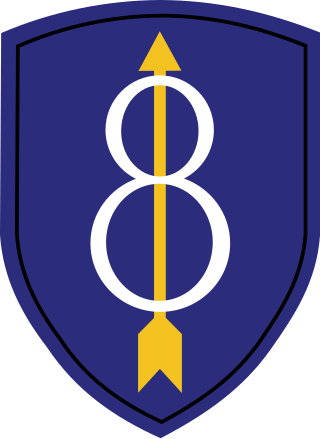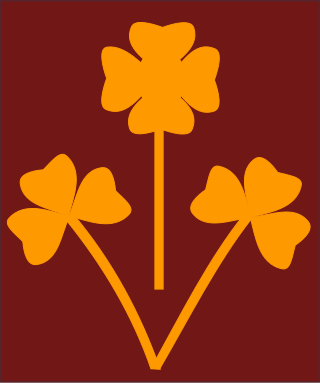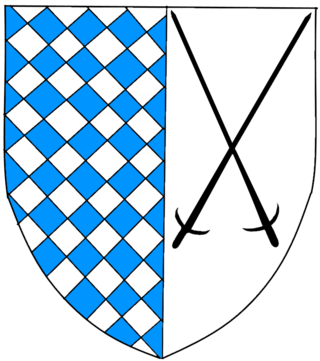
The 36th Infantry Division ("Arrowhead") also known as the "Panther Division", the "Lone Star Division", "The Texas Army", and the "T-patchers", is an infantry division of the U.S. Army and part of the Texas Army National Guard. The 36th Infantry Division was first organized during World War I (1914–1918) from units of the Texas and Oklahoma National Guards. After the war, the division was reformed as an all-Texas unit, and was called to service for World War II (1937–1945) on 25 November 1940, was deployed to the European Theater of Operations in April 1943, and returned to the Texas National Guard in December 1945.

The 1st Infantry Division (1ID) is a combined arms division of the United States Army, and is the oldest continuously serving division in the Regular Army. It has seen continuous service since its organization in 1917 during World War I. It was officially nicknamed "The Big Red One" after its shoulder patch and is also nicknamed "The Fighting First". The division has also received troop monikers of "The Big Dead One" and "The Bloody First" as puns on the respective officially sanctioned nicknames. It is currently based at Fort Riley, Kansas.

The 8th Infantry Division, ("Pathfinder") was an infantry division of the United States Army during the 20th century. The division served in World War I, World War II, and Operation Desert Storm. Initially activated in January 1918, the unit did not see combat during World War I and returned to the United States. Some units would serve in the American Expeditionary Force to Siberia. Activated again on 1 July 1940 as part of the build-up of military forces prior to the United States' entry into World War II, the division saw extensive action in the European Theatre of Operations. Following World War II, the division was moved to West Germany, where it remained stationed at the Rose Barracks in Bad Kreuznach until it was inactivated on 17 January 1992.

The 61st Infantry Division was a combat division of the German Army during the Second World War. Towards the end of the war, it became the 61st Volksgrenadier Division.

The 5th Indian Infantry Division was an infantry division of the Indian Army during World War II that fought in several theatres of war and was nicknamed the "Ball of Fire". It was one of the few Allied divisions to fight against three different armies - the Italian, German and Japanese armies.

The 18th Infantry Regiment ("Vanguards") is an infantry regiment of the United States Army. The regiment currently exists with one active battalion, under the U.S. Army Regimental System; regimental designation is used only for historical tradition, and there is no active regimental headquarters. The 18th Infantry once had up to four active battalions, but three have been inactivated:

The 8th Mountain Division was raised as the 7th Indian Infantry division of the British Indian Army. It is now part of the Indian Army and specialises in mountain warfare.

The 6th Armoured Division was an armoured division of the British Army, created in September 1940 during the Second World War and re-formed in May 1951 in the UK.
The 131st Infantry Brigade, originally the Surrey Brigade was an infantry formation of Britain's Territorial Army that saw service during both the First and the Second World Wars. In the First World War the brigade was in British India for most of the war and did not see service as a complete unit but many of its battalions would see service in the Middle East.
The 299th Infantry Division was a German Army infantry division in World War II. It fought France and the Russian Front until February 1945.
The 11th Indian Infantry Brigade was an infantry brigade formation of the Indian Army during World War II. It was relocated from India to Egypt in the middle of August 1939 and trained at Fayed in Ismailia Governorate on the Great Bitter Lake. In October 1939, it was assigned to the 4th Indian Infantry Division. In May 1942, it was attached to the 5th Indian Infantry Division and in June the 2nd South African Infantry Division when it surrendered after Tobruk was captured by the Germans and Italians in 1942. The brigade was then reformed in Egypt in October 1943 and once more assigned to the 4th Indian Division serving in Tunisia, Italy and, at the end of the war, in Greece.
The 17th Indian Infantry Brigade was an infantry brigade formation of the Indian Army during World War II.

The 31st Infantry Division was a German infantry division of the Army during World War II. It participated in the invasion of Poland in 1939 then the invasion of France and the Low Countries in 1940. As part of Panzergruppe 2. of Army Group Centre, it was involved in the invasion of the Soviet Union in June 1941. After hard fighting throughout 1941 and 1942 it joined the 9th Army and fought in the Battle of Kursk in July and August 1943. Along with the rest of the 9th Army, the division conducted a fighting withdrawal for the remainder of 1943, during which it sustained heavy casualties. In the early stages of the Soviet Operation Bagration of June to August 1944, the 31st Infantry Division was destroyed, a fate which subsequently befell most of Army Group Centre. The division was officially disbanded on 18 July 1944.

The 41st Field Artillery Regiment is a field artillery regiment of the United States Army.

The 338th Infantry Division was a division of the German Army in World War II.
The 42nd Rifle Division was a unit of the Red Army during the Great Patriotic War. The division, first formed in 1940, was nearly destroyed in the opening days of the Operation Barbarossa defending the Brest Fortress. Disbanded in late December 1941 and immediately reformed in the Volga Military District. The division then served on the front until disbanded at the end of the war.
Major-General Sir Ivor Thomas Percival Hughes, was a senior British Army officer who fought in both the world wars. During the Second World War he commanded the 44th Division during the Battle of Alam el Halfa and the Second Battle of El Alamein in late 1942 and later became Serjeant-at-Arms of the House of Commons.

Wilhelm Josef Daser was a German military officer who commanded the 70th infantry division of the Wehrmacht during the Battle of the Scheldt and surrendered unconditionally on 6 November 1944 in Middelburg.
The 196th Infantry Division was an infantry division of the German Heer during World War II.
The 270th Infantry Division was an infantry division of the German Heer during World War II.
This page is based on this
Wikipedia article Text is available under the
CC BY-SA 4.0 license; additional terms may apply.
Images, videos and audio are available under their respective licenses.












